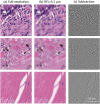Length-scale study in deep learning prediction for non-small cell lung cancer brain metastasis
- PMID: 39333630
- PMCID: PMC11436900
- DOI: 10.1038/s41598-024-73428-2
Length-scale study in deep learning prediction for non-small cell lung cancer brain metastasis
Abstract
Deep learning-assisted digital pathology has demonstrated the potential to profoundly impact clinical practice, even surpassing human pathologists in performance. However, as deep neural network (DNN) architectures grow in size and complexity, their explainability decreases, posing challenges in interpreting pathology features for broader clinical insights into physiological diseases. To better assess the interpretability of digital microscopic images and guide future microscopic system design, we developed a novel method to study the predictive feature length-scale that underpins a DNN's predictive power. We applied this method to analyze a DNN's capability in predicting brain metastasis from early-stage non-small-cell lung cancer biopsy slides. This study quantifies DNN's attention for brain metastasis prediction, targeting features at both the cellular scale and tissue scale in H&E-stained histological whole slide images. At the cellular scale, the predictive power of DNNs progressively increases with higher resolution and significantly decreases when the resolvable feature length exceeds 5 microns. Additionally, DNN uses more macro-scale features associated with tissue architecture and is optimized when assessing visual fields greater than 41 microns. Our study computes the length-scale requirements for optimal DNN learning on digital whole-slide microscopic images, holding the promise to guide future optical microscope designs in pathology applications and facilitating downstream deep learning analysis.
© 2024. The Author(s).
Conflict of interest statement
The authors declare no competing interests.
Figures










Similar articles
-
On the robustness of deep learning-based lung-nodule classification for CT images with respect to image noise.Phys Med Biol. 2020 Dec 22;65(24):245037. doi: 10.1088/1361-6560/abc812. Phys Med Biol. 2020. PMID: 33152716 Free PMC article.
-
Impact of stain variation and color normalization for prognostic predictions in pathology.Sci Rep. 2025 Jan 18;15(1):2369. doi: 10.1038/s41598-024-83267-w. Sci Rep. 2025. PMID: 39827151 Free PMC article.
-
Automated curation of large-scale cancer histopathology image datasets using deep learning.Histopathology. 2024 Jun;84(7):1139-1153. doi: 10.1111/his.15159. Epub 2024 Feb 26. Histopathology. 2024. PMID: 38409878
-
Artificial intelligence: Deep learning in oncological radiomics and challenges of interpretability and data harmonization.Phys Med. 2021 Mar;83:108-121. doi: 10.1016/j.ejmp.2021.03.009. Epub 2021 Mar 22. Phys Med. 2021. PMID: 33765601 Review.
-
Deep computational pathology in breast cancer.Semin Cancer Biol. 2021 Jul;72:226-237. doi: 10.1016/j.semcancer.2020.08.006. Epub 2020 Aug 17. Semin Cancer Biol. 2021. PMID: 32818626 Review.
References
-
- Falk, T. et al. U-Net: Deep learning for cell counting, detection, and morphometry. Nat. Methods16, 67–70. 10.1038/s41592-018-0261-2 (2019). - PubMed
MeSH terms
Grants and funding
- 13520296/Sensing to Intelligence (S2I)
- 13520296/Sensing to Intelligence (S2I)
- 13520296/Sensing to Intelligence (S2I)
- 13520296/Sensing to Intelligence (S2I)
- HMRI-15-09-01/Heritage Research Institute for the Advancement of Medicine and Science at Caltech
- HMRI-15-09-01/Heritage Research Institute for the Advancement of Medicine and Science at Caltech
- HMRI-15-09-01/Heritage Research Institute for the Advancement of Medicine and Science at Caltech
- HMRI-15-09-01/Heritage Research Institute for the Advancement of Medicine and Science at Caltech
- U01CA233363/CA/NCI NIH HHS/United States
LinkOut - more resources
Full Text Sources
Medical

